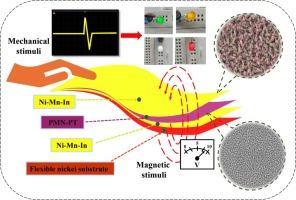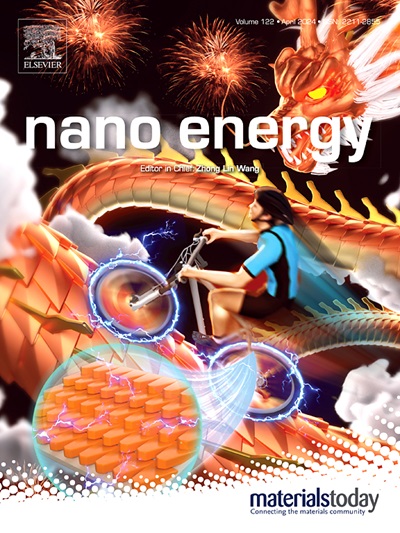利用基于 PMN-PT/Ni-Mn-In 的柔性压电纳米发电机获取机械能和磁能
IF 16.8
1区 材料科学
Q1 CHEMISTRY, PHYSICAL
引用次数: 0
摘要
多功能压电纳米发电机(PENG)在开发军事、医疗保健和工业领域的智能传感技术方面具有巨大潜力。在此,我们介绍了利用直流/射频磁控溅射技术在柔性镍基底上制造的基于 0.67Pb (Mg1/3Nb2/3)O3-0.33PbTiO3 (PMN-PT) / Ni50Mn35In15 (Ni-Mn-In) 的压电纳米发电机从机械和磁场刺激中高效采集能量的情况。通过使用各种砝码、手指敲击、弯曲和磁场施加 0.12 至 0.61 N 的力,对该器件的性能进行了评估。在施加 0.61 N 的力和手指敲击的情况下,该装置产生的最大开路电压(Voc)分别为 9.3 V 和 6 V。相应的短路电流(Isc)分别为 1.33 µA(0.61 N)和 0.9 µA(手指敲击)。在弯曲角度为 120° 时,器件显示出 10.6 V 的最大 Voc 和 1.51 µA 的 Isc。此外,在 0 Oe 至 500 Oe 的直流磁场下,Voc 和 Isc 分别从 0 mV 和 0 nA 增加到 240 mV 和 35 nA。所制造的器件功率密度为 2.7 µW/cm2,机械稳定性高达 2500 次循环。此外,绿色、红色、黄色和白色的发光二极管均已点亮。所制造的 PENG 对机械和磁刺激的接受能力突出表明了它在触觉传感、可穿戴电子设备、人机界面和生物医学设备等领域的潜力。本文章由计算机程序翻译,如有差异,请以英文原文为准。

Harnessing the Mechanical and Magnetic Energy with PMN-PT/Ni-Mn-In-based Flexible Piezoelectric Nanogenerator
Multifunctional piezoelectric nanogenerators (PENG) hold significant potential in developing smart sensing technologies for the military, healthcare, and industrial sectors. Here, we present the efficient energy harvesting from mechanical and magnetic stimuli in 0.67Pb (Mg1/3Nb2/3)O3-0.33PbTiO3 (PMN-PT) / Ni50Mn35In15 (Ni-Mn-In)-based PENG fabricated on a flexible nickel substrate using the DC/RF magnetron sputtering technique. The performance of the device has been assessed by imparting forces in the range of 0.12 to 0.61 N using various weights, finger tapping, bending, and magnetic fields. The device generates the maximum open circuit voltage (Voc) of 9.3 V and 6 V with 0.61 N of force and finger tapping, respectively. The corresponding short circuit current (Isc) has been obtained as 1.33 µA (0.61 N) and 0.9 µA (finger tapping). The device shows a maximum Voc of 10.6 V and Isc of 1.51 µA at the bending angle of 120°. Furthermore, the Voc and Isc have increased from 0 mV and 0 nA to 240 mV and 35 nA under the presence of 0 Oe to 500 Oe of DC magnetic field, respectively. The fabricated device exhibited a power density of 2.7 µW/cm2 with a high mechanical stability of 2500 cycles. Additionally, LEDs of green, red, yellow, and white color have been illuminated. The receptiveness of the fabricated PENG towards mechanical and magnetic stimuli highlights its potential in areas such as tactile sensing, wearable electronics, human-machine interfaces, and biomedical devices.
求助全文
通过发布文献求助,成功后即可免费获取论文全文。
去求助
来源期刊

Nano Energy
CHEMISTRY, PHYSICAL-NANOSCIENCE & NANOTECHNOLOGY
CiteScore
30.30
自引率
7.40%
发文量
1207
审稿时长
23 days
期刊介绍:
Nano Energy is a multidisciplinary, rapid-publication forum of original peer-reviewed contributions on the science and engineering of nanomaterials and nanodevices used in all forms of energy harvesting, conversion, storage, utilization and policy. Through its mixture of articles, reviews, communications, research news, and information on key developments, Nano Energy provides a comprehensive coverage of this exciting and dynamic field which joins nanoscience and nanotechnology with energy science. The journal is relevant to all those who are interested in nanomaterials solutions to the energy problem.
Nano Energy publishes original experimental and theoretical research on all aspects of energy-related research which utilizes nanomaterials and nanotechnology. Manuscripts of four types are considered: review articles which inform readers of the latest research and advances in energy science; rapid communications which feature exciting research breakthroughs in the field; full-length articles which report comprehensive research developments; and news and opinions which comment on topical issues or express views on the developments in related fields.
 求助内容:
求助内容: 应助结果提醒方式:
应助结果提醒方式:


